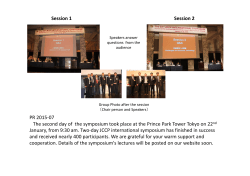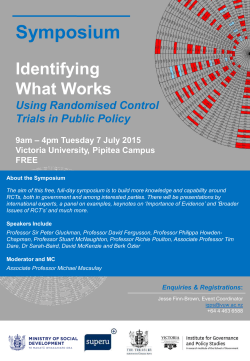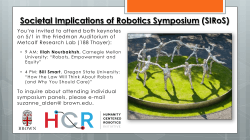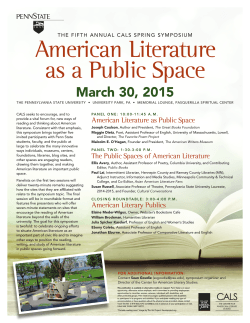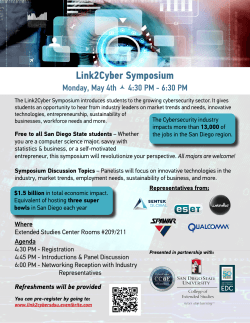
Did you know?
May, 2015 Welcome to Message in a Bottle! Although the spring semester may be IMPORTANT DATES winding down for many, we can see from the symposium abstracts that • May 15, 2015 this has been a very busy and productive year. We are excited to hear Final genome annotations all about it at the symposium, and to share our plans and aspirations due. See phagesdb.org for for the coming SEA-PHAGES year. It is an especial delight to see the protocols eLife paper emerge from a somewhat complex manuscript preparation, submission, review, and production process. But it is a real landmark • June 12-14, 2015 publication and we extend a big thank you to everyone for helpful input Annual Symposium at JRC Graham F. Hatfull at every step of the process. The broad genomic analyses described in Lead Scientist the paper have also facilitated constructive consideration of how the sci- • June 15-17, 2015 Advanced In Silico Workshop ence should progress in the next few years. I think it is evident that as exciting as the analysis is, at HHMI HQ that claiming even a slight scratch on the surface of viral diversity would be an optmistic description. So what’s next? Clearly, we need to keep clawing away at phage genomics, and continue the • June 21-27, 2015 process that we’ve already started to discover and characterize phages of additional – but phyIn situ workshop A at UMBC logenetically-proximal – hosts. We’ve not met a phage that we didn’t like, but we look forward • July 12-18, 2015 to the exploration and genomics of Actinomycetales phages as being the primary scientific focus In situ workshop B at UMBC of the SEA-PHAGES community over the next few years. We predict it will be an especially rich seam of viral diversity in which to explore. • More at seaphages.org A CONTINUUM OF DIVERSITY We are excited at the publication of the paper “Whole genome comparison of a large collection of mycobacteriophages reveals a continuum of phage genetic diversity” in the open access online journal eLife. The 627 phages analyzed in this collection were isolated and annotated by 2644 students at 81 institutions, and in addition to the scientific insights, supports the effectiveness of the SEA-PHAGES program as an authentic research experience for early-career undergraduate students. With a grand total of 2,863 authors, it is one of the most highly-authored papers ever, and it must be a record for the number of undergraduate authors on a single paper! We’ve not yet caught up with the current division leader (the Higgs-Boson report has about 6,000 authors) but it’s nice to be in such distinguished company. Congratulations to everyone. Did you know? Temperate vs. lysogenic NEW ACTINOMYCETES HOSTS FOR FALL 2015 Now that we’ve examined the whole genome sequences of 627 mycobacteriophages, what next? We will continue to isolate and sequence Mycobacterium smegmatis phages, but will also move towards the use of other hosts within the phylum Actinobacteria for phage isolation. In addition to the Arthrobacter and Rhodococcus strains already in use by some schools, we are looking forward to distributing new strains of Dietzia, Gordonia, Rhodococcus, Mycobacterium, Nocardia, Tsukamurella, Corynebacterium and others. Exploring this segment of viral diversity-space will be the signature focus of SEA-PHAGES in the next few years, and evaluating these strains will require a community effort.We look forward to further discussions at the symposium. SEA-PHAGES: A community of researchers exploring phage diversity A common error in phage-related vocabulary is to use the phrase “lysogenic” to indicate that a phage is capable of establishing itself harmlesly in the cell as well as undergoing lytic growth. Such cells are “lysogens” and the dormant phage genome is a “prophage”. However, phages with this ability are called “temperate” phages, not “lysogenic” phages. Lysogeny is maintained by a repressor, but the prophage may be either integrated site-specifically into the host chromosome, or can replicate autonomously extrachromosomally --similar to a large plasmid --and use a plasmid partioning system to prevent prophage loss during cell division. Message in a Bottle For more information contact: info@seaphages.org 2015 SEA-PHAGES SYMPOSIUM PUBLICATIONS OF INTEREST We are looking forward to the 2015 Annual SEA-PHAGES Symposium • Cresawn et al. (2015) at the Janelia Research Campus (June 12-14th), and are delighted that Comparative genomics of ClusEric Betzig will be our keynote speaker on Friday evening. Eric shared ter O Mycobacteriophages. the Nobel prize for Chemistry in 2014 for the development of superPLoSONE. 10:e0118725. resolved fluorscence microscopy and is a Group Leader at the Janelia • Hoskisson et al. (2015) Research Campus.This year will also feature student moderators for The phage growth limitation the scientific sessions, and student introducers for Drs. Betzig and Hatsystem in Streptomyces coelifull. Thanks to all the faculty members who submitted nominations for color A(3)2 is a toxin/antitoxin these positions. We will also hear from some of our SEA-PHAGES faculty members in a session system, comprising enzymes highlighting their research. Photo: http://janelia.org/people/scientist/eric-betzig with DNA methyltransferase, protein kinase and ATPase ac2015 SEA-PHAGES ASSESSMENT WORKSHOP tivity. Virology 477, 100-109. The first SEA-PHAGES assessment workshop was held at HHMI HQ • Liu et al. (2015) in March 2015. Led by Dr. David Hanuaer, 15 SEA-PHAGES faculty The diversity and host interacmembers met to review and improve assessment tools they developed tions of Propionibacterium and implemented at their institutions. Faculty members learned how to acnes bacteriophages on human validate their assessment instruments, how to measure student socioskin. ISME J. doi: 10.1038/ emotional variables accurately, and discussed methods for student tracking. We look forward to ismej.2015.47. future workshops and assessment reports. TRANSITIONS • Pope et al (2015) Whole genome comparison of a large collection of We are busily adding functionality to the new http://seaphages.org mycobacteriophages reveals website, which is now the go-to place for SEA-PHAGES programmatic a continuum of phage geinformation.You’ve probably already visited the site to submit course netic diversity” eLife 4:e06416. data, update faculty contact information, see the calendar of upcoming events, and read the blog; and there’s much more to come in the next couple of months. Please note that primary program information will be disseminated through info@seaphages.org, so please add the email to your address book! The list of SEA-PHAGES membership benefits and responsibilities is also posted there, which we hope will provide useful and practical guidelines as you plan for your upcoming year of phage discovery and genomics. As THE SEA-PHAGES TEAM: Graham Hatfull (Pitt) the SEA-PHAGES community grows, being mindful of these will be increasingly important. SEA HIGHLIGHTS We are delighted to welcome Viknesh Sivanathan as the newest addition to the SEA-PHAGES leadership team. Vic comes to us from Ann Hochschild’s lab at Harvard Medical School, and has much experience working in bacterial and bacteriophage biology. Welcome aboard, Vic! We also welcome Gonzaga faculty member Marianne Poxleitner, who will be spending her sabbatical working on SEA-PHAGES projects in the coming year, as well as Sharon Isern and Scott Michael from Florida Gulf Coast University who are working with Kevin to teach the In Situ workshops for Cohort 8 this summer. David Asai (HHMI) Billy Biederman(HHMI) Charlie Bowman (Pitt) Kevin Bradley (HHMI) Steve Cresawn (JMU) Debbie Jacobs-Sera (Pitt) Crystal Petrone (Pitt) Welkin Pope (Pitt) Dan Russell (Pitt) Vic Sivanathan (HHMI) Want to contribute to Message in a Bottle? Send your information to us at info@seaphages.org! SEA-PHAGES: A community of researchers exploring phage diversity Message in a Bottle For more information contact: info@seaphages.org
© Copyright 2025

